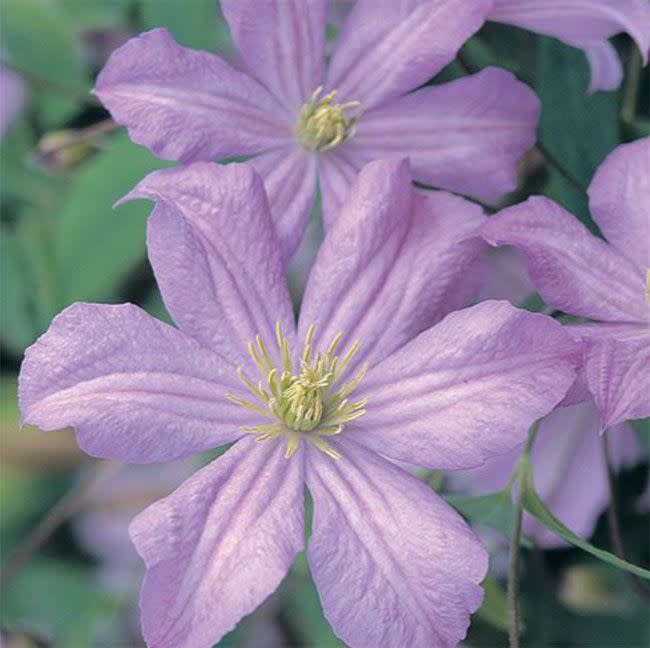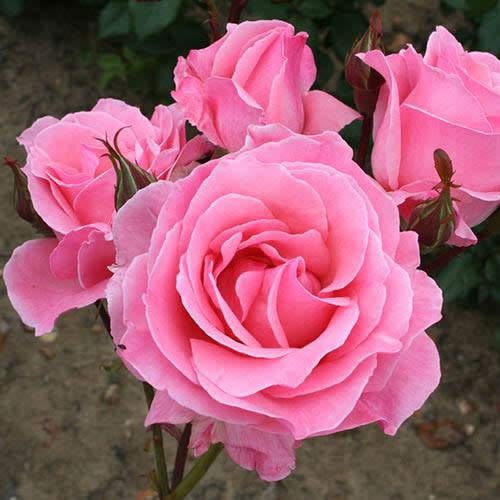King Charles' royal garden essentials – and how to recreate the look at home

King Charles' royal residences may all be unique with their own rich histories and opulent features, but there are a few key features that have been found to be the same at all of them.
Each garden at His Majesty's homes – which he inherited from the Queen in September 2022 – features eight non-negotiable features that the late Queen loved, many of which are easy to incorporate into your own outdoor space for a royal-approved summer update.
WATCH: The Queen shares tour of royal garden
They include sentimental flowers and historic relics, such as a clematis named after Prince Philip at Windsor Castle, the Welsh national flower, Daffodils, and a special feature which the Queen previously said allowed her some "peace and quiet".
RELATED: 7 royal-approved gardening tips from the King, Princess Anne and more
Sophie Birkert, founder and designer of Screen With Envy, shares the key features and special meaning behind them here…
Clematis
Clematis can be found in all of the King's gardens
Clematis is the queen of climbers, scrambling up trellises, climbing over arbours and threading themselves through other plants. There are many varieties of the plant featured throughout all of the palace gardens, including this beautiful purple variety featured at Windsor Castle, named after the late Prince Philip.
GALLERY: Inside 11 beautiful royal gardens
As the ultimate climbers, you can buy them fully grown and add them to a wall in your garden for a beautiful backdrop or to hide any eyesores, such as garden storage. While they are known for their long, flowering vines, you can contain the plant in a pot for a more polished look. Alternatively, you can add clematis to your tablescape, bringing a burst of colour and sweet-smelling fragrance to any space.

FROM £24.99 AT THOMPSON & MORGAN
Daffodils
Daffodils are another key feature in the King's gardens
As daffodils are the national flower of Wales, they held a special place in the late Queen's heart, and are found in all of the royal residence gardens. In fact, the Queen even had a daffodil created for her in 2012 called the Narcissus 'Diamond Jubilee', and other varieties of the flowers especially bred for her. While you won’t be able to get your hands on these special varieties, there are others, such as the Tazetta daffodils and the fragrant Pheasant's Eye daffodils, that are easy to find.
Bulbous flowers are a great addition to any garden as they make gorgeous bouquets to enjoy inside or brighten up a yard when most other plants are still awakening. Daffodils have long, slender leaves and stems, so if you’re planting some, keep in mind they can be taller than other varieties.

Pink and red roses
Pink and red roses appear to be a favourite of the royals'
The late Queen loved roses, and they are featured throughout all six private gardens at the royal residences which now belong to King Charles, including beds of 3,500 rose bushes planted in a geometric pattern at Windsor Castle.
According to the Royal Collection Trust, some of the sweetly fragranced roses were picked and used in table decorations at banquets. At Buckingham Palace, there are 60 rose bushes that grow in each of the 25 beds, each chosen for its fragrance, colour and disease resistance. However, it is red and pink roses that appear in all of the King's gardens.
Take inspiration from the royals and use roses as a centrepiece or create a floral installation. Whether it's a single blush bloom or a bright collection of unexpected shades, there's no wrong way to include the bud's multiple varieties and colourways.

MORE: How to design your garden like the royals
Statues
There are many historic statues in the King's gardens
From a mysterious 19th-century fiddler in the garden of the Palace of Holyroodhouse to a bronze figure of an ancient Roman man at Windsor Castle, a royal garden just wouldn't be complete without a statue. They have great historical significance and range in date from the late 15th century to modern times. According to the Royal Collection Trust, statues and busts have played an important role alongside painted portraits in the commemoration of successive sovereigns.
The statues vary significantly from painted terracotta busts and bronze statuettes to marble busts, so there’s not really a 'one size fits all' when it comes to creating your own royal garden statue. While it may not be feasible to create a statue fit for royalty in your own backyard, you can certainly create the look with mini statues, gnomes, metallic spheres and concrete wildlife.
SHOP: The gardening tools to buy now for summer
Hedges
Hedges not only look great in the King's royal gardens, but they are also very practical, helping to add privacy to the vast spaces. At Sandringham House, there are colourful plants surrounded by pristine hedgerows. While at Hillsborough Castle, the keeper of the Walled Garden, Adam Ferguson, says he reimagined the feature by incorporating symmetrical structural hedging to introduce colour and excitement to the space.
The great thing about hedges is they are very popular throughout the UK, so, chances are, you already have one. Depending on where the hedge is, you can centre your table close to it to give your space a touch of privacy while creating a lovely backdrop for your garden party.
While a full-fledged hedge may not be possible in a small backyard or balcony, you can opt for something less intrusive such as a climber or bamboo. If you decide to add more greenery to your outdoor space for privacy, ensure you research beforehand to find a plant that will give you the coverage you need. We recommend Canna Musifolia with large, paddle-shaped leaves and exotic flowers, a banana palm such as Red Abyssinian, Colocasia (Elephant Ears) and Fatsia Polycarpa 'Green Fingers.'
Woodland walk
A stroll through ancient woodlands is truly a magical experience and a feature that is prominent in all of the royal residences. When speaking about the semi-secret element in Buckingham Palace's private gardens, the woodland path behind the herbaceous border, the late Queen said she used it on occasions "when she wants some peace and quiet". Meanwhile, Balmoral is a perfect example of a country estate typical of the mid-19th century with parkland and woodland set within the dramatic and charming Highland scenery.
While you may not have an ancient forest on your doorstep, you can certainly incorporate elements of the woodlands into your garden party. Mosses and lichens will add velvet and colour to your garden, and, in spring, there will be a pageant of wildflowers, such as primroses and bluebells. You can also grow climbers into the branches, such as ivy and honeysuckle, to give your space a woodland feel. Alternatively, you can put up some homes for wildlife, such as nest boxes that will encourage birds.
Herbaceous Border
Beautiful herbaceous borders are a mainstay in royal gardens
From Buckingham Palace's 156-metre herbaceous border to Sandringham House Garden's beautiful herbaceous borders designed by renowned landscape architect Geoffrey Jellicoe, it's a must-have in any royal garden. In spring, there are beautiful displays of rhododendrons and magnolias, and the gardens are informally planted in a cottage garden style. The borders are a display of colours from reds, oranges and yellows through to blues, mauves and a complete sensory overload.
From delphiniums and phloxes to daylilies and heleniums, there is no shortage of flowers featured. Bold varieties like plume poppies (Macleaya) draw the attention of your eye, while the dark green backdrop of shrubs creates a perfect canvas for all the colours. Pick a colour theme, start planting, and fill in with matching and contrasting plants as the season and the years go on.
However, herbaceous perennials can take months to grow, so if you’re short on time, incorporate some of these varieties in pots or as decorative features around your outdoor space.
Pergola
A pergola is a key feature in a royal garden
There's no shortage of pergola inspiration in the monarch's private gardens as they have been popular features from Roman times onwards. One of the most beautiful is Buckingham Palace's wisteria-clad pergola, while at Hillsborough Castle, Lady Alice Temple has provided a quiet space for contemplation for many residents of the castle.
A pergola is a great addition to any garden, particularly if you do a lot of outdoor hosting in the summer months, and it will protect your guests from the glaring sun. Just be sure to look into whether or not you’ll need a permit for your project before you get started.
Alternatively, you can decorate an existing patio or porch cover to enhance shade and style. If you’re looking for a more permanent structure, ensure that it’s made from wood or composite materials to prevent it from looking weathered after a short period of outdoor exposure.
If you have the time and skills, you can build your own pergola out of wood panels and decorate it with paper lanterns, hanging plants or sheer curtains for an added element of privacy.
Make sure you never miss a ROYAL story! to get all of our celebrity and royal news delivered directly to your inbo



